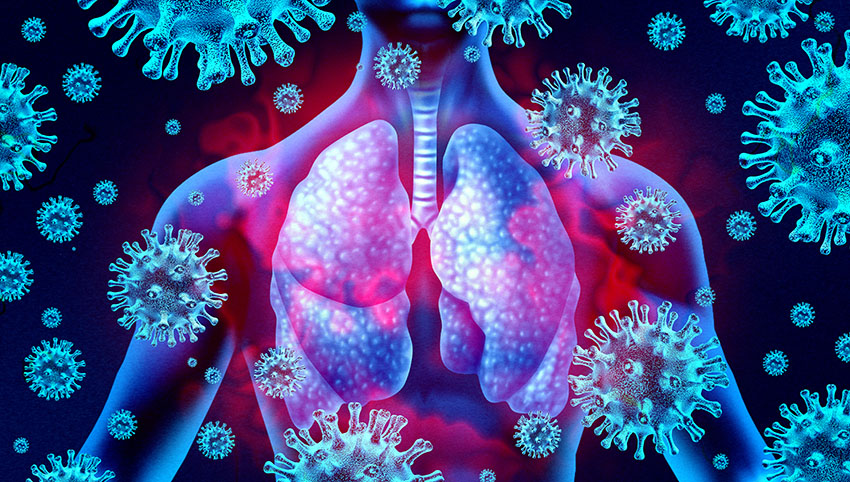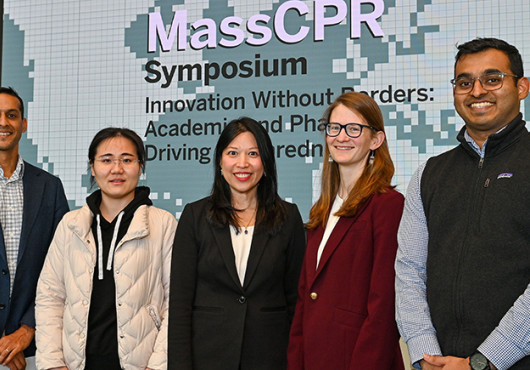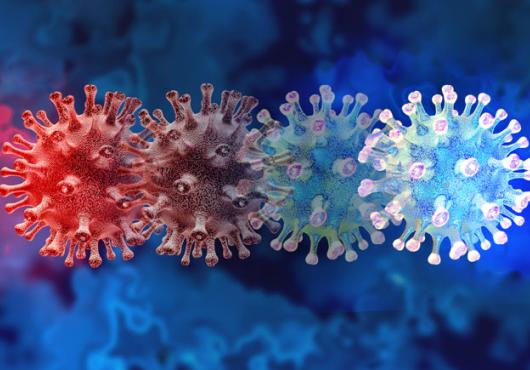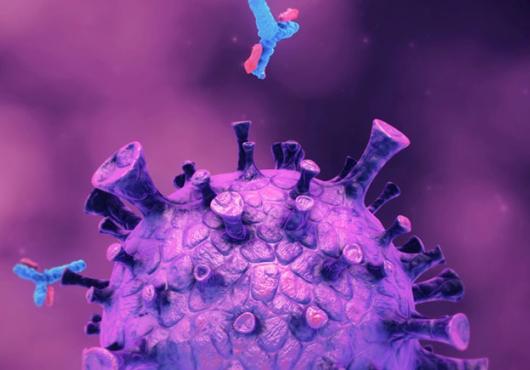
Photo: wildpixel/iStock/Getty Images Plus
This article is part of Harvard Medical School’s continuing coverage of medicine, biomedical research, medical education, and policy related to the SARS-CoV-2 pandemic and the disease COVID-19.
Since the beginning of the pandemic, once-esoteric scientific terms have become common parlance—spike protein, PCR, mRNA.
Pathogenesis is not one of them. Yet, when it comes to understanding COVID-19, this may well be the most important word that has yet to make its way into the mainstream lexicon.
Pathogenesis—or “origin of disease”—is the study of the processes that give rise to physiologic dysfunction and illness. In the case of COVID-19, it is the study of virus-induced mischief—how SARS-CoV-2 interacts with various cells, tissues, and organs to cause COVID-19.
As the world inches along on its journey through this ever-evolving pandemic, understanding the “how” of COVID-19 could be the most important question of all.
The question has motivated the research of Galit Alter and David Knipe over the last year. The two co-lead the pathogenesis research group of the Massachusetts Consortium on Pathogen Readiness (MassCPR), a multi-institutional, cross-disciplinary, international research effort established on March 2, 2020, at Harvard Medical School to help combat the current pandemic and set the stage for fighting future ones.
Alter is a professor of medicine at HMS and an investigator at the Ragon Institute of MGH, MIT, and Harvard. Knipe is a professor of microbiology and molecular genetics in the Blavatnik Institute at HMS.
A year after the World Health Organization declared COVID-19 a global pandemic, Alter and Knipe discussed what they have learned about the disease-fueling interplay between the SARS-CoV-2 and its human host and their ongoing efforts to understand the shifting landscape of COVID-19.

A triad of disease
The archetypal triad of infectious diseases involves a host, a pathogen, and the interaction between the two. To understand the mechanisms of infection, neither the human host nor the pathogen can be studied in isolation—a disease is invariably a function of the interplay between the two.
- The pathogen—the structure and behavior of the virus and how it evolves over time under various pressures around it.
- The host—the underlying individual factors—genetics, differences in immune response, overall health, age—determine how and why a virus might affect one person differently from another to cause a range of disease manifestations.
COVID-19 has demonstrated a stunning versatility in not only in the range of its severity—from asymptomatic to deadly—but also in range of organs and organ systems it can affect.
- The interplay—the host and pathogen are engaged in an ongoing battle. The field where this battle unfolds is the immune system. The host immune response powerfully modifies how the virus behaves once inside the body, the magnitude of the infection, the severity of the disease, and the risk for organ damage and complications.
Yet, understanding COVID-19, or any complex disease for that matter, is not a simple equation of summing up the individual parts. Each of the three variables carries multiple unknowns within itself. In a way, understanding the pathogenesis of COVID-19 is akin to solving a three-body problem, a notorious challenge in classical mechanics.
“The study of pathogenesis is essentially puzzle-solving,” Knipe said. “It’s a systems approach to studying a disease, so one of the roles of our group is to put together the pieces of knowledge from areas of study to explain the system.”
Alter and Knipe emphasize that a comprehensive understanding of COVID-19 pathogenesis should go beyond how the virus behaves inside the human host. That classic view may be limiting. Alter points out that the host-pathogen interaction is but one link in a long chain of biologic events.
“We are trying to ask every single question about this virus—how it infects, how it causes disease, how it affects the world around us but also how the virus survives in nature so that we can be prepared for the next coronavirus,” Alter said. “We are focused on everything that the pathogen can interact with, what allows it to survive and persist, and that’s a much bigger scope of inquiry.”
To be sure, that scope is staggering, but scientists have also generated immense knowledge about an entirely new human virus causing an entirely new human disease, and they have done so at a pace never before achieved in the history of science and medicine.
This growing knowledge has defined the contours of the disease and filled in many critical blanks. Here are some of the key insights gleaned by researchers from MassCPR’s pathogenesis working group.
The pathogen: survival of the wiliest
The structure of SARS-CoV-2 was elucidated early in the pandemic, and the virus’s genome was sequenced and published in early January 2020—mere weeks after the first reports out of Wuhan, China.
The pathogen’s behavior has posed more of a challenge. One critical blind spot early in the pandemic was asymptomatic and pre-symptomatic viral transmission, which posed a major hurdle in halting the spread of the virus.
Another behavioral quirk of SARS-CoV-2 is how quickly it has changed. Researchers anticipated that the virus would mutate. They knew that new SARS-CoV-2 variants would emerge eventually. What blindsided them was the extent to which some of the viral mutants could dodge antibody defenses.
Another baffling observation was that some mutations were arising in geographically remote parts of the world. The virus, the researchers realized, was developing natural evolutionary workarounds against host immune defenses.
In the early months of the pandemic, the assumption—and hope—was that SARS-CoV-2 would not change too fast because, unlike most of its fellow RNA viruses, it has a “proofreading” protein whose job is to prevent too many changes to the viral genome.
But the virus did change, and researchers worry that if vaccine rollout remains sluggish, the viral changes may outpace our ability to keep up with them.
Know thine enemy
A microbe has only one goal—to survive and propagate. To achieve this, a virus must change in response to its environment. These adaptive changes occur through mutation. Mutations are a normal part of the life cycle of a virus and happen every time a virus makes copies of itself.
Some mutations are of no consequence, others can harm the virus itself, and still others can become advantageous to the microbe, allowing it to propagate more easily from host to host or to dodge the host’s immune defenses. If a mutation gives a virus an evolutionary advantage, this fitter variant can gradually outcompete others and become the dominant one.
On a basic level, to survive long-term, any organism must engage in a delicate balancing act between safeguarding its genome against too many mutations and introducing new adaptive mutations that render it better adapted to survive in its environment.
“The whole viral evolution story has been puzzling,” Knipe said. “We thought initially the virus was pretty stable genetically, but the variants with the same multiple changes have arisen in several geographic areas. This not a gradual evolution.”
Rather, Knipe added, recent studies suggest that viral recombination—or shuffling of segments of the viral RNA—may lead to new, more infectious genetic combinations of mutations.
In the case of SARS-CoV-2, most mutations emerge simply as a consequence of adapting to a new host. Best current evidence suggests that SARS-CoV-2 made its way into people from bats, a transition that compels the virus to get better and better at invading the cells of its new host.
Other mutations to SARS-CoV-2 appear to arise in response to pressure from the host’s immune system. To ensure its survival inside the human host, the virus comes up with workarounds—escape mutations—that allow it to dodge immune defenses.
The most common, and best understood, immune defense is neutralizing antibodies, immune proteins that block the virus from entering and infecting cells. To prevent SARS-CoV-2 from entering human cells, antibodies latch onto an area of the virus called the receptor-binding domain (RBD). Logic would dictate that the virus would first develop escape-enabling mutations in this vulnerable part of its structure but, to the researchers’ surprise, mutations are now appearing on other parts of the virus as well.
“The virus is not changing only where the antibodies attack,” Knipe said. “It’s changing throughout the genome. Why is it changing so much all the way through?”
The question is also a clue.
This observation raises an interesting hypothesis. It suggests that the virus may be experiencing immune pressure elsewhere on its genome and that such pressure does not arise from the antibody response. This indicates that antibodies are not the only troops deployed by our immune system to disable the enemy, Knipe said.
The emergence of viral variants that appear to be more transmissible points to the ability of the virus to shapeshift rapidly in response to immune pressure. This, in turn, highlights the importance of immunizing large swaths of the population, thereby reducing the number of hosts for the virus to infect and the number of opportunities to mutate.
Understanding viral behavior mandates aggressive genomic surveillance of SARS-CoV-2 but, just as importantly, research into how coronaviruses, in general, and other viruses replicate, Knipe said. The information derived from studying viral behavior, he added, can help scientists guess the pathogen’s next moves, such as the appearance of novel mutations, and factor them into the design of broadly acting therapies and vaccines that target multiple sites of vulnerability on the virus.
History teaches us that we just don’t know where the next pathogen might come from, so we can’t take our eyes off the ball. We have to use what we have learned about SARS-CoV-2 and use this knowledge to continue basic science research into other pathogens.
David Knipe
MassCPR had this vision of bringing together epidemiology, therapeutics, diagnostics, clinical medicine, and more to create these pillars of fighting a disease. Now, imagine if we did the same for every other disease. Imagine doing this for breast cancer, for Parkinson’s. Just think about what we could accomplish if we could form these Manhattan projects.
Galit Alter





